Türkic Genetic
Charts |
· |
Тюркские Генетические
Графики
|
|
Genetics and Physical Anthropology |
Генетика и Антропология |
|
|
|
Foreword |
Введение
|
A first glance at the graphs gives an impression of amazing biological diversity
within the Türkic group. The biological diversity is commensurate with the modern
geographical diversity and the diversity of the Scythian times, when the Türkic nomadic
Scythians filled chronicles from the Mediterranean As-guzai to the Huanhe Zhou. That
diversity is contrasting with the gentle and sluggish clines of the sedentary
agriculturists.
All graphs must be taken with a grain of salt, as the Tuvinian graphs demonstrate, but within reason
they help in understanding demographical history. So, the Bashkirs, Chuvashes, Tatars and Turks have
a substantial admixture with Finno-Ugric women, as can be readily be seen from the graphs. Khakassians, Sakha (Yakuts),
Todjins, Tofalars, Tuvinians have a substantial admixture with Tungus women, including Mongol
women. Others will also gain their counterparts, as the old preconceptions keep falling, and new studies, especially those distinguished by the scientists' sincere and innocent expressions of surprise, come around.
A significant factor that distinguishes Türkic people is a strict rule of exogamy, when a
particular tribe had a permanent marital partner in another tribe. These marital relations were not
symmetrical: while the women from the “khatun“ tribe were available to the dominating
male tribe, the males of the “khatun“ tribe were disadvantaged, and had to have their separate “khatun“ tribe. This directional flow of genes, which lasted for dozens of generations, can't be overlooked
in proficient genetical analyses.
Another factor that distinguishes Türkic people was caused
by the nature of nomadic conquests. The female-transferred mtDNA carried by mostly male armies
already in the second generation get replaced on mass scale by the mtDNA of the local women,
creating very diverse mtDNA maps within reconstituted populations. A second generation inherits only half of the maternal genes, the third generation - one quarter, etc. In the West, this creates an mtDNA picture with a predominance of the Western Asian or Western clades, and correspondingly in
the East this creates an mtDNA picture with a predominance of the East Asian haplogroups. In either
case, a genetical assessment made without a complimentary picture of the male Y-chromosomes, or
without accounting for the effect of mtDNA replacement, can't be relied upon. The phenomenon of mtDNA
replacement equally applies to any predominantly male mass migrations.
Eventually, each compound Türkic ethnic group will gain its own genetic map showing
genetics for each seok and separate ethnic subgroup.
|
Первый же взгляд на графики производит впечатление невероятного биологического
разнообразия Тюркской группы. Биологическое разнообразие соизмеримо с современным
географическим разнообразием и разнообразием Скифских времен, когда Тюркские кочевые Скифы
заполняли хроники от Средиземноморских Ас-гузай до Чжоу на Хуанхе. Это разнообразие
контрастирует с нежными и вялыми переходами оседлых земледельцев.
Все графики должны рассматриваться со щепоткой соли, как показывают Тувинские графики, но в рамках
резонного они помогают пониманию демографической истории. Так, Башкиры, Чуваши, Татары и Турки имеют значительную
примесь Угро-Финских народов, как явно видно из графиков. Хакассы, Саха (Яакуты), Тоджины, Тофалары, Тувины
имеют значительную примесь Тунгуских женщин, включая Монгольских женщин. Другие тоже получат своих партнеров,
по мере развеивания старых предубеждений, и прихода новых исследований, оссобенно тех что отмечены чистосердечными и невинными выражениями удивления
ученых.
Существенный фактор отличающий Тюркские народы - это жесткое правило экзогамии, когда племя имеет постоянного брачного партнера в другом племени. Эти брачные отношения не были симметричными: в то время как женщины из “хатунского“ племени были доступны доминирующему племени мужчин, мужчины “хатунского“ племени были дискриминированы, и должны были иметь свое
отдельное “хатунское“ племя. Этот направленный поток генов, продолжающийся множество поколений,
не может быть упущен квалифицированными генетическими исследованиями.
Другой фактор, отличающий Тюркские народы вызван характером кочевнических завоеваний. Передаваемый женщинами
мтДНК несомый в основном мужскими армиями уже во втором поколении заменяется в массовом масштабе на
мтДНК местных женщин, создавая очень разнообразные мтДНК карты в воссозданном населении.
Ко второму поколению переходит только половина материнских ген, к третьему - одна
четверть, и т.д. На Западе, это создает
мтДНК картину с подавляющей долей Западназиатских или Западных групп, и соответственно на Востоке это
создает мтДНК картину с подавляющей долей Восточноазиатских хаплогрупп. В обоих
случаях генетическая оценка, сделанная без сопутствующей картины мужских Y-хромосом, или без учета эффекта
замены мтДНК, не может быть правильной. Явление замены мтДНК одинаково относится
к любым в основном мужским массовым миграциям.
В какой-то момент, каждое национальльное объединение
Тюркских этнических групп получит свою генетическую карту
показывающую генетику для каждого сеока и отдельной этнической подгруппы. |
| Overview |
L. Gumilev outlined this advance sketch on the back of a napkin, it was reproduced in his book
Ancient Huns, 1969, to place Huns in a demographic context, and remained static ever since. It
was intended to depict contents of his book, and since the Huns were but a branch of the Türkic
trunk, it left out a bulk of the crown on the Türkic Genealogical Tree. The Zhous, who ruled China
for much longer than the Chinese ruled themselves, for example, are not named, they are indicated by
the terminal points of the Sya (Xsia) and Huns. The western Scythians were left out, they were
indicated by the terminal point of Sakas. Kushans, Tokhars were left out, they were indicated by the
terminal point of Uechji (Yueji). Abdaly (Ephthalites) were indicated by the terminal point of the
branched Huns, etc. As a graphic manifesto, the sketch however remains a roadmap for Turkology and a
memorial to
L. Gumilev. On a higher level a 3D version of the same map would show the English branch. Together with
Germanic peoples, Hungarians, Rajputs, Jats, Ukrainians, Southern and Eastern Russians, Durranies, Northern and
Northwestern Chinese, and uncounted other groups, it carries a heavy Türkic streak in its language,
its traditions, and in its veins. Many old discoveries of the old Germanic linguists related to the
“Indo-European” phylum are the traces left in the local languages by the Türkic people, the prime of
these traces are the mama and father, the Türkic mamü and ata
respectively. In a more detailed depiction, the Tree would also show the Cimmerian (Kimri), Scythian
(Juts, Frisians), Alanic (Amorican Norse), and other links from the Türkic Tree to English. These
links are visible on the genetic graphs, they are rigidly impressed in the genetic composition of
the populations, and they correlate with demographic ratios in the population pools. |
Л. Гумилев набросал этот быстрый эскиз на салфетке, и так он и был воспроизведен в
книге Древние Хунны, 1969, поместив Хуннов в демографический контекст, и до сих пор он
остается неизменимым. Эскиз графически показывал содержание его книги, и так как Хунны были лишь ветвью
Тюркского ствола, он не показал большую часть кроны Тюркского Генеалогического Древа. Например,
Чжоу, которые правили Китаем гораздо дольше чем Китайцы правили сами собой, не названы, они
обозначены конечными точками Ся (Xsia) и Хуннов. Западные Скифы опущены, они указаны конечной
точкой Саков. Кушаны, Тохары опущены, они указаны конечной точкой Уэчжи (Yueji). Абдалы (Эфталиты)
указаны конечной точкой отпочкования Хуннов, и т.д. Как графический манифест этот эскиз, однако,
остается дорожной картой Тюркологии и вечным памятником Л. Гумилеву.
На более высоком уровне трехмерная версия той же карты показала бы Английскую ветвь.
Вместе с Германскими народами, Венграми, Раджпутами, Джатами, Украинцами, Южными и Восточными
Русскими, Дьюранами, Северными и Северо-Западными Китайцами, и бесчисленными другими группами, она
несет весомый Тюркский след в ее языке, ее традициях, и в ее жилах. Многие старые находки старых
германских лингвистов, относящиеся к "Индо-Европейской" семье, являются следами оставленными Тюрками в
местных языках, важнейшими такими следами являются слова мама (мама) и отец (father),
соответственно mamü (мамю) и ata
(ата) у Тюрксков. В более детальном изображении, Древо также
покажет Киммерийскую (Kimri), Скифскую (Джуты, Фризы), Аланскую (Амориканские Норманы), и другие
связи Тюркского Древа с его Английской ветвью. Эти связи видны на генетических графиках, они
нестираемы в генетическом составе населений, и они коррелируют с демографическими пропорциями населений. |
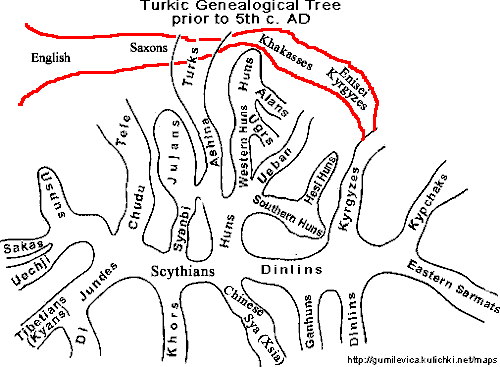 |
| mtDNA = mamas |
Graphs show what would happened after waves after waves of
migrations would keep replacing their maternal mtDNA with the local mtDNA over and over again.
Depending on particular circumstances would change the appearance of the migrants and the locals,
their language even if not completely replaced, their traditions, and their culture. The male-driven
economy, military aptitude, class structure, and social organization would be propagated. |
Графики показывают, что бы произошло кагда волна за волной миграции опять и опять заменяют материнскую
мтДНК местной мтДНК. В зависимости от конкретных обстоятельств будет меняться
внешний облик мигрантов и местных, их язык даже если не полностью замещенный, их традиции,
и их культура. Принесенные мужчинами тип хозяйства, военные традиции, кастовые структуры и
социальная организация выживут и возьмут верх. |
Fedorova et al., 2003
Analysis of Mitochondrial DNA Lineages in Yakuts
http://evolutsioon.ut.ee/publications/Fedorova2003.pdf |
Follow up on Table 3. mtDNA Haplogroup frequency distribution in the gene pools of Türkic ethnic groups
and North-East Asian indigenous populations
Fedorova et al., 2003

| Population |
mtDNA Haplogroup graph |
Population |
mtDNA Haplogroup graph |
|
Türkic ethnic groups |
Abdaly (Abzeli of Bashkortstan)/Ephtalites
(added) |
Information inaccessible,
sorry |
Alats (Alayundu, Ch. Boma) from Konya, Turkey
Konya area is also populated by Afshars, Bayundurs, Begdili, Bugduz (Büğdüz) - Alkaevli,
Döğers/Dügers/Digors/Tuhsi/Tokhars/ Tochars, Kayı, Salurs, Varsak/Uar Saka/War Saka/Avars,
Yörük/Yiva/Iyrk/Iurcae/ Hyrcae/Yancai |
Information inaccessible,
sorry |
Altaians (N = 110)
60,000 populationThe generic Altaian Y-DNA makes as much sense as the generic Belgian
DNA: Belgium is a geographical-political, not biological category. The Altaian Türks
consist of two different biological phylums, each consisting of numerous biologically
different tribes. See details. |
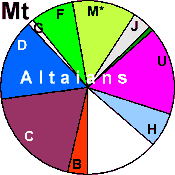 |
Altaians (Northern) Nenetses (Dubo, Tuva),
Ugrians (Finno-Ugrians, Magyars)
Syanbi
Turco-Turco-Mongolic
Türkic Toba (Tabgach, Ch. Pin. Tuoba)
Tele and Old Türks
See details, p. 193 |
Information inaccessible,
sorry |
| Altaians (Altai kiji, Southern) Tele 29.6%
Türks 22.2%
Enisei Kyrgyzes 12%
Naimans (10.4%), Keraits, and others
See details. |
 |
Azeri (added)
Quite a motley soup that reflects a long road of Azeri Scythians from the Altai
highlands to the Near East, to Sakacene state, to hosting a long sequence of guests,
invaders and intruders, and still coming ahead as the longest-surviving descendents of
the Scythian Ash-guzai. Azeri are remote relatives of other As tribes
across Eurasia: Yazygs, Balkars, Karachais, and many more.
Note the Hg X (4%), restricted to northern Amerindians, including Ojibwa, Nuu-Chah-Nulth, Sioux,
and Yakima, and Na Dene-speaking Navajo (Brown et al. 1998) |
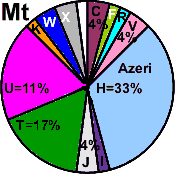 |
| Balkars (added) |
Information inaccessible,
sorry |
Bashkirs
Note the Hg X (4%), restricted to northern Amerindians, including Ojibwa, Nuu-Chah-Nulth, Sioux,
and Yakima, and Na Dene-speaking Navajo (Brown et al. 1998) |
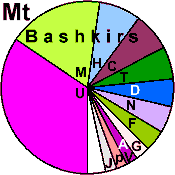 |
| Bulgar (Türkic) |
Information inaccessible,
sorry |
|
|
Chuvash
Note the Hg X (1%), restricted to northern Amerindians, including Ojibwa, Nuu-Chah-Nulth, Sioux,
and Yakima, and Na Dene-speaking Navajo (Brown et al. 1998) |
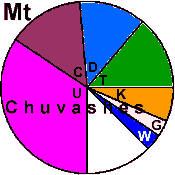 |
Digors (N.Ossetia) Also spelled under local versions:
Dügers (Turkmenistan),
Tukhsi/Tuhsi (Altai-Sayan),
Döğer (Turkey),
Tochar/Tokhar/Dahae (fr. Gr.) |
Information inaccessible,
sorry |
| Dolgans |
Information inaccessible,
sorry |
|
|
| Gagauzes |
Information inaccessible,
sorry |
Gilan (Tr. Snake) is one of most ancient and prominent Türkic tribes, in the western
Eurasia they are known as Djilan, Yilan, Gilaki (Iran), Gilan (Afganiatan, Pakistan),
Kayi (Turkey) and Hailandur (Caucasus), Kumyk (Caucasus), Zmiev and Cheshuev (Russian), Gelon
(Herodotus), and in the east as Kayi, Qiang (China), Xi/Si/Kumosi 奚 (China), Kian, Uran
and Uryan, Uryanhayi/Uryankhai; Kai (Mongolian, Russian). “Old” Hunnic maternal dynastic
tribe Huyan (Ch. 呼衍、呼延). Kayi is Mongolian translation
of Djilan. |
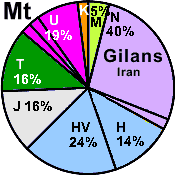 |
| Gujarati (Abdaly//Ephtalite tribe) |
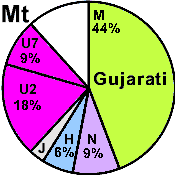 |
Karakalpaks |
Information inaccessible,
sorry |
| Kazakhs |
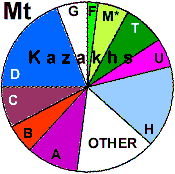 |
Khakassians Khakassian - modern name for descendents of Enisei Kyrgyz |
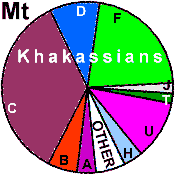 |
| Kumyks Kumyks are a blend of Kayi Huns (Hailandurs) = an “old” maternal
dynastic tribe of Luyanti Huns, plus Aghvans (Aluans/Albans, Western and South Kumyks) supplanted
by Savir “Huns” (Bulgars, Khazars, Savirs, and Barsils), plus Masguts/Alans (See
description). |
Information inaccessible,
sorry |
Kyrgyz Descendents of Enisei Kyrgyz |
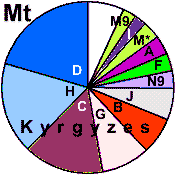 |
| Rajput (Abdaly/Ephtalite tribe) |
Information inaccessible,
sorry |
|
|
| Nogais Nogais must be among the world record holders on diversity of their female
partners. Their biography is definitely most exciting, they traveled much, saw a lot, and
must be among the healthiest people on Earth.
Note the Hg X (4%), restricted to northern Amerindians, including Ojibwa, Nuu-Chah-Nulth, Sioux,
and Yakima, and Na Dene-speaking Navajo (Brown et al. 1998) |
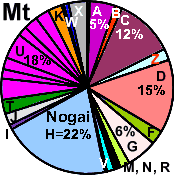 |
Pazyryks (added, per
I.V.Kulikov et al.) |
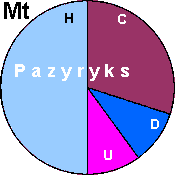 |
| Sakha (Yakuts) |
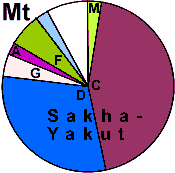 |
Soyots |
 |
| Shorians |
 |
|
|
| Turkmens Turkmens include distinct components that
blur, or just show the complexity, of the genetic picture |
Information inaccessible,
sorry |
Tuvinians (n=36)
100,000 population |
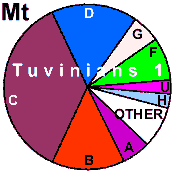 |
| Tatars |
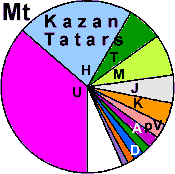 |
Todjins (N = 48) |
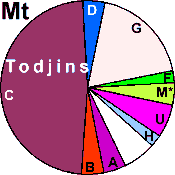 |
Tofalars (N = 58)
700 (seven hundred) population |
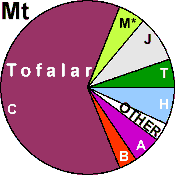 |
Turks (added)
Note the Hg X (3%), restricted to northern Amerindians, including Ojibwa, Nuu-Chah-Nulth, Sioux,
and Yakima, and Na Dene-speaking Navajo (Brown et al. 1998) |
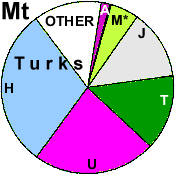 |
| Turkmens Turkmens include distinct components that
blur, or just show the complexity, of the genetic picture
Note the Hg X (2.4%), from unknown seok, restricted to northern Amerindians, including Ojibwa, Nuu-Chah-Nulth, Sioux,
and Yakima, and Na Dene-speaking Navajo (Brown et al. 1998) |
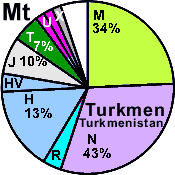 |
Tuvinians (n=458)
100,000 population |
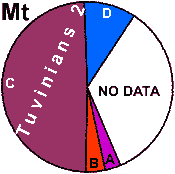 |
Uigurs
Note the Hg X (1%), restricted to northern Amerindians, including Ojibwa, Nuu-Chah-Nulth, Sioux,
and Yakima, and Na Dene-speaking Navajo (Brown et al. 1998) |
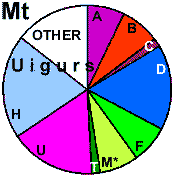 |
Uzbeks (added) |
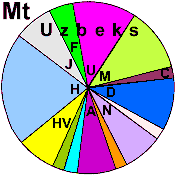 |
|
Caucasus populations (Adygs, Nakhs, Kartvels, Armenians) |
| Adyg |
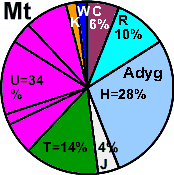 |
|
|
|
North-West Asian populations (Uralic/Ugro-Finn ethnic groups) |
Komi-Permyaks
Note the Hg X (4%), restricted to northern Amerindians, including Ojibwa, Nuu-Chah-Nulth, Sioux,
and Yakima, and Na Dene-speaking Navajo (Brown et al. 1998) |
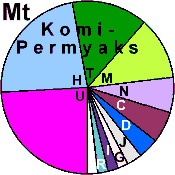 |
Udmurts |
 |
| Komi-Zyryans |
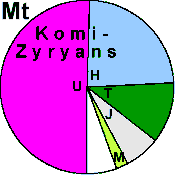 |
Mordvins |
 |
| Mari |
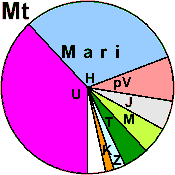 |
|
|
| |
|
|
|
|
North-West Asian populations (Uralic/Nenets ethnic groups) |
| Nenets |
|
|
|
|
North-East Asian populations |
|
Chukotko-Kamchatkan language family Chukcha,
Eskimo
ethnic groups |
| Chukcha |
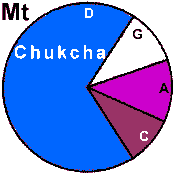 |
Eskimo |
 |
| Koryaks |
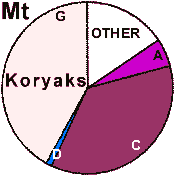 |
Itelmen |
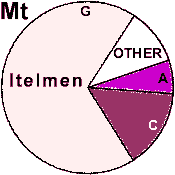 |
| |
|
|
|
| Tungus (Ch. Dunhu), Manchu, Koreans, Japanese |
| Evenks |
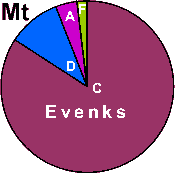 |
Evens |
 |
| |
|
|
|
| Mongolia (Mongols) |
Buryats
200,000 population in Russia |
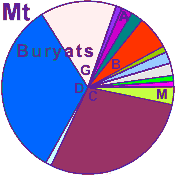 |
Mongols |
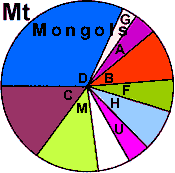 |
| |
|
|
|
| |
|
Demographic Notes |
The Altaians, the native people of Altai Republic (south Siberia) number up to 60,000 people.
“Altaians“ is the common denomination for seven formerly distinct Turkic-speaking groups: the
Altai-Kiji, Teleuts, and Telengits, who are southern Altaians, and the Chelkans, Kumandins, Tubalars, and Maimalars, who are northern Altaians. The differences between southern and northern
Altaians are well established, on the basis of anthropological, linguistic, and classical
genetic-marker studies (Potapov 1969; Alexeev and Gohman 1984; Luzina 1987).
Anthropologically, southern Altaians Altai-Kiji, Teleuts, and Telengits are typical central Asian Mongoloids (like Mongolians, Yakuts,
and Buryats), whereas northern Altaians Chelkans, Kumandins,
Tubalars, and Maimalars exhibit Caucasoid anthropological features, similar
to those of other Türkic, Ugric and Samoyedic groups. X-haplogroup represents a minor
founding lineage that is restricted in distribution to northern Amerindian groups, including the
Ojibwa, the Nuu-Chah-Nulth, the Sioux,
and the Yakima, as well as the Na Dene-speaking Navajo (Brown et al. 1998) |
| Y-DNA = papas |
Fedorova et al., 2003
Follow up on Table 3. mtDNA Haplogroup frequency distribution in the gene pools of Türkic
ethnic groups
and North-East Asian indigenous populations
Color Codes (double check for accuracy)

| Population |
Y-DNA Haplogroup graph |
Population |
Y-DNA Haplogroup graph |
|
Türkic ethnic groups |
Abdaly (Abzeli of Bashkortstan)/Ephtalites
http://ftp.anrb.ru/molgen/Lobov_AS.PDF |
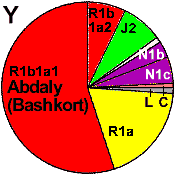 |
Alats (Alayundu, Ch. Boma) from Konya, Turkey
Konya area is also populated by Afshars, Bayundurs, Begdili, Bugduz (Büğdüz) - Alkaevli,
Döğers/Dügers/Digors/Tuhsi/Tokhars/ Tochars, Kayı, Salurs, Varsak/Uar Saka/War Saka/Avars,
Yörük/Yiva/Iyrk/Iurcae/ Hyrcae/Yancai
Alats also go as Khalages, Nuristani Kalasha, and the like |
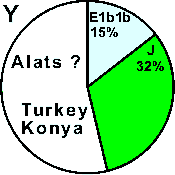 |
| Altaians Altaian Y-DNA makes as much sense as Belgian
DNA: Belgium is a geographical-political, not biological category. The Altaian Türks
consist of two different biological phylums, each consisting of numerous biologically
different tribes. See details. |
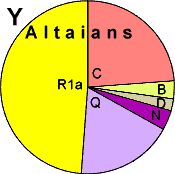 |
Altaians (Northern) Nenetses (Dubo, Tuva),
Ugrians (Finno-Ugrians, Magyars)
Syanbi
Turco-Turco-Mongolic
Türkic Toba (Tabgach, Ch. Pin. Tuoba)
Tele and Old Türks
See details, p. 193 |
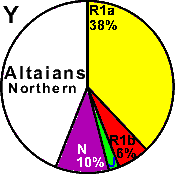 |
| Altaians (Altai kiji, Southern) Tele 29.6%
Türks 22.2%
Enisei Kyrgyzes 12%
Naimans (10.4%), Keraits, and others |
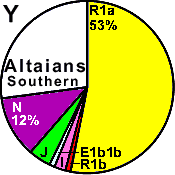 |
|
|
| Azeri - free (11% - others not shown; partial test is suspicious) |
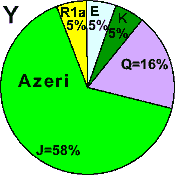 |
Azeri - Iran |
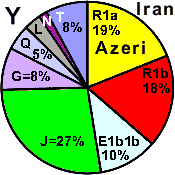 |
| Balkars |
 |
Bashkirs |
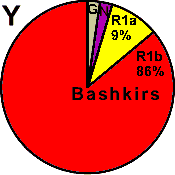 |
| Bulgar (Türkic) |
Information inaccessible,
sorry |
Chuvash
| Data of 2020 - drastic difference vs. 2010 |
| R1b |
R1a |
I |
J |
N |
| 3.8 |
31.6 |
11.3 |
24.2 |
27.8 |
|
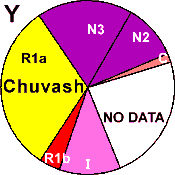 |
| Digors (N.Ossetia) Also spelled under local versions:
Dügers (Turkmenistan),
Tukhsi/Tuhsi (Altai-Sayan),
Döğer (Turkey),
Tochar/Tokhar/Dahae (fr. Gr.) |
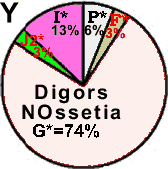 |
Dolgans |
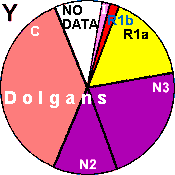 |
| Gagauzes Komrat |
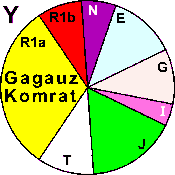 |
Gagauzes Kongaz |
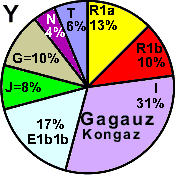 |
| Gagauzes Etulia |
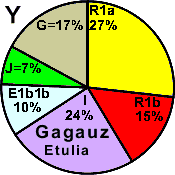 |
|
|
Gilan (Tr. Snake) is one of most ancient and prominent Türkic tribes, in the western
Eurasia they are known as Djilan, Yilan, Gilaki (Iran), Gilan (Afganiatan, Pakistan),
Kayi (Turkey) and Hailandur (Caucasus), Kumyk (Caucasus), Zmiev and Cheshuev (Russian), Gelon
(Herodotus), and in the east as Kayi, Qiang (China), Xi/Si/Kumosi 奚 (China), Kian, Uran
and Uryan, Uryanhayi/Uryankhai; Kai (Mongolian, Russian). “Old” Hunnic maternal dynastic
tribe Huyan (Ch. 呼衍、呼延). Kayi is Mongolian translation
of Djilan. |
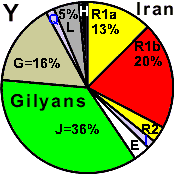 |
Gujarati (Abdaly/Ephtalite tribe) |
Information inaccessible,
sorry |
| Karachai |
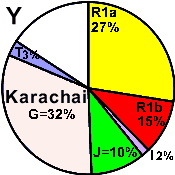 |
Karakalpaks |
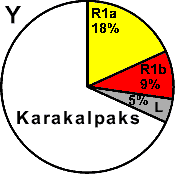 |
| Kazakhs |
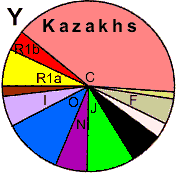 |
Khakassians Khakassian - modern name for descendents of Enisei Kyrgyz |
Information inaccessible,
sorry |
| Kumyks Kumyks are a blend of Kayi Huns (Hailandurs) = an “old” maternal
dynastic tribe of Luyanti Huns, plus Aghvans (Aluans/Albans, Western and South Kumyks) supplanted
by Savir “Huns” (Bulgars, Khazars, Savirs, and Barsils), plus Masguts/Alans (See
description). |
 |
Kumyks No 2 |
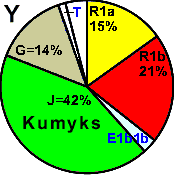 |
| Kyrgyz Descendents of Enisei Kyrgyz |
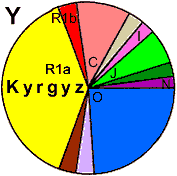 |
|
|
Lurs (Iran)
Lurs are Dravidians, Hg Q links Lurs with Turkmens and South Asia, Hg L links Lurs with South
Asia |
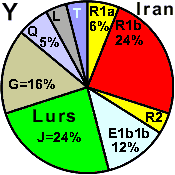 |
Rajput (Ephtalite tribe) 1500 years and a continent apart, the Y haplogroups of Rajputs
and Abdaly (Abzeli of Bashkortstan)/Ephtalites still share Hg R1a and L |
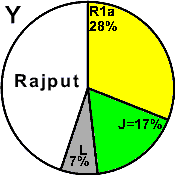 |
| Sakha (Yakuts) |
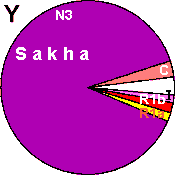 |
Shorians |
Information inaccessible,
sorry |
| |
|
Soyotes |
Information inaccessible,
sorry |
| Tatars |
 |
Todjins (N = 48) |
Information inaccessible,
sorry |
| Tofalars (N = 58) |
Information inaccessible,
sorry |
|
|
| Turkmens (Iran) |
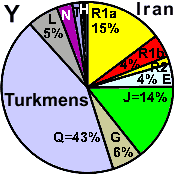 |
Turks (Turkey) Because of extreme heterogeneity, Y-DNA
of Turkish Türks is not an ethnic, but a geographical-political category that in a
hit-and-run mode encompasses anybody from Italy to Korea and therefore genetically, the whole Y-DNA
is an alphabetical soup. |
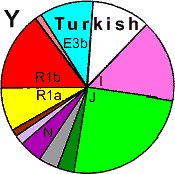 |
| Tuvinians (n=458) |
Information inaccessible,
sorry |
Tuvinians (n=36) |
Information inaccessible,
sorry |
| Uigurs |
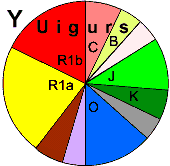 |
Uigurs (EastTurkestan) |
 |
| Uigurs (Urumchi) |
 |
Uigurs (Yili river nomads) |
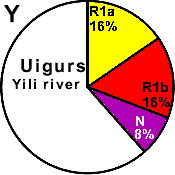 |
| Uzbeks |
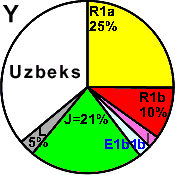 |
Yiyrks (Iran) |
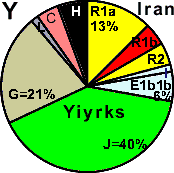 |
|
North-West Asian populations (Ugro-Finn ethnic groups) |
|
Hungarians In 10th c. Magyars moved to Pannonia 50/50 with Bulgarian Kubars, and
found land full with Türkic Huns, Avars, Bulgars, Seklers, plus Slavs, plus Germanics, plus plus plus.
Plus later additions of Kumans, Kipchaks, Germans, Jews, etc. HP N shows how little is
Finnic blood |
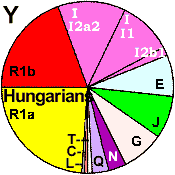 |
|
|
| Komi |
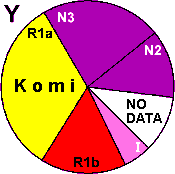 |
Udmurts |
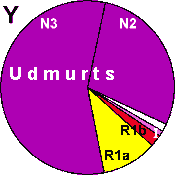 |
| Mari |
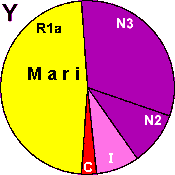 |
Mordvins (Burtases) |
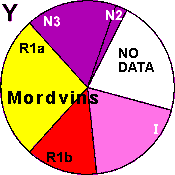 |
| |
|
|
|
| |
|
|
|
|
North-West Asian populations (Uralic/Nenets ethnic group) |
| Nenets |
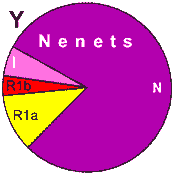 |
Selkups |
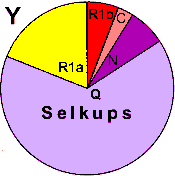 |
| Nganasans |
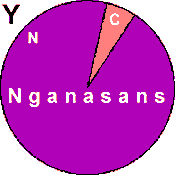 |
Kets (lang. Isolate) |
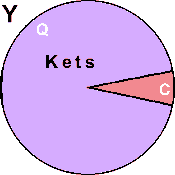 |
|
North-East Asian populations |
|
Chukotko-Kamchatkan language family Chukcha,
Eskimo
ethnic groups |
| Chukcha |
Information inaccessible,
sorry |
Eskimo |
Information inaccessible,
sorry |
| Koryaks |
Information inaccessible,
sorry |
Itelmen |
Information inaccessible,
sorry |
| |
Information inaccessible,
sorry |
|
Information inaccessible,
sorry |
| Tungus (Ch. Dunhu), Manchu, Koreans, Japanese |
| Evenks |
 |
Evens |
Information inaccessible,
sorry |
| |
|
|
|
| Mongolia (Mongols) |
| Buryats |
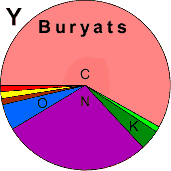 |
Mongols |
 |
|
European populations |
Croats (Hrvati)
formerly Besenyo tribe Charaboi |
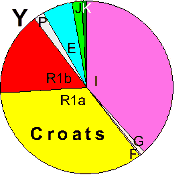 |
|
|
| |
|
|
|
| |
|
|
|
| |
|
| |
|























































































